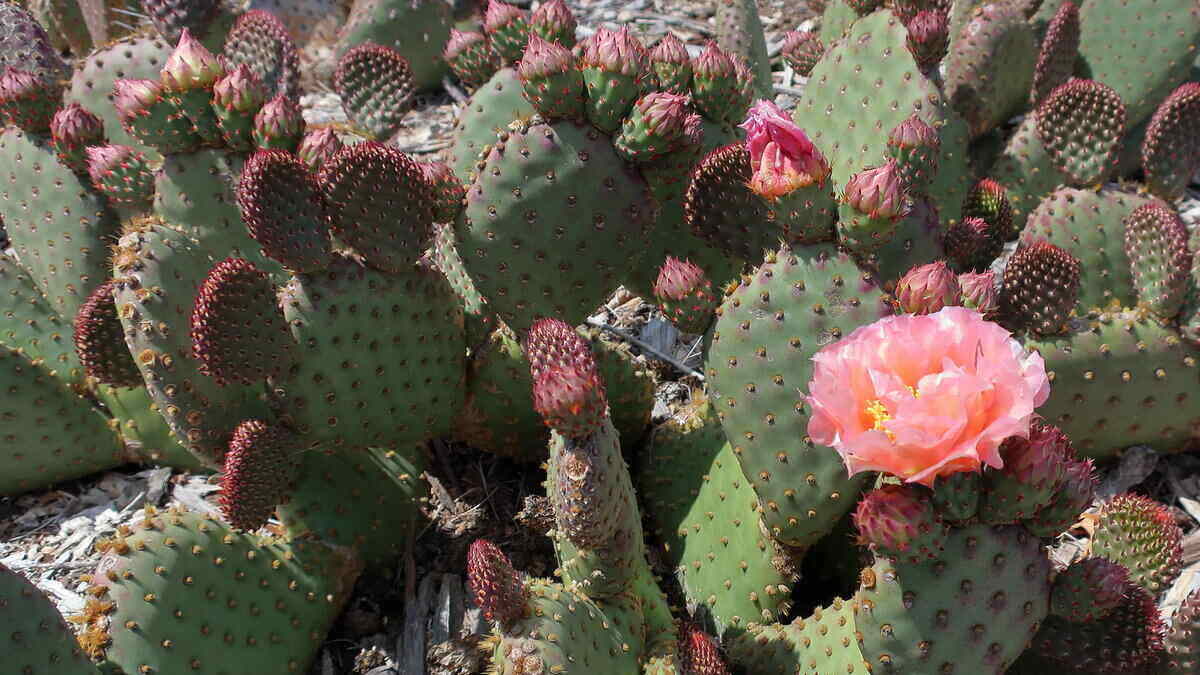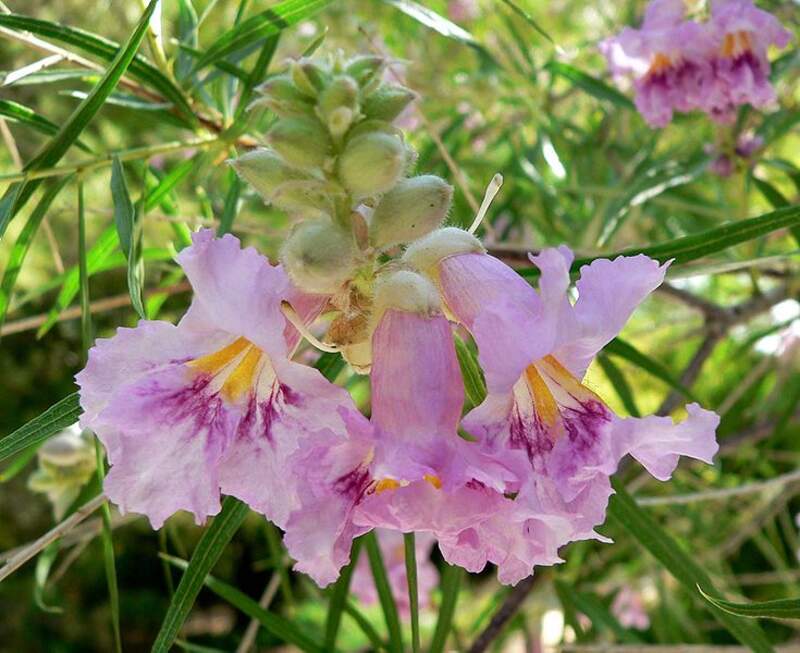
If your Valley of the Sun landscaping is withering in the Sonoran Desert heat, discover what native plant species can help alleviate your desert landscaping woes.
Advantages of Arizona native plants:
- Use little to no water or are drought-tolerant
- Attract native wildlife, including hummingbirds and butterflies
- Maintain the balance of the local ecosystem
According to The National Wildlife Federation, a native plant is a plant that “has occurred naturally in a particular region, ecosystem, or habitat without human introduction.” In other words, these Arizona plants have been living in the Southwest for at least several hundred years. So, you know these species will be successful when you plant them in your home lawn.
Cacti and succulents
1. Saguaro (Carnegiea gigantea)

If you’re looking for a desert plant to pass on to your grandkids, the saguaro may be the plant for you. These cacti grow very slowly from seed and can live to be over 200 years old. Once established, these cacti offer a focal point for home desert landscapes.
- Plant type: Cactus
- Hardiness zones: 9
- Sun: Full sun
- Water needs: After establishment, none
- Soil: Well-drained
- Duration: Perennial
- Mature height: 25-50 feet
2. Parry’s agave (Agave parryi)

Parry’s agave, also known as a century plant, makes a nice accent plant in arid landscapes. This evergreen plant can be installed on its own or in a group. Parry’s agave grows in a rosette pattern and will flower after 10-25 years. Its flower buds are red, while the flowers are a bright yellow. The height of the stalk and the time it takes to flower can vary widely, so check the plant tag before you buy.
- Plant type: Succulent
- Hardiness zones: 7-11
- Sun: Full sun
- Water needs: After establishment, none or very little
- Soil: Well-drained
- Duration: Perennial
- Mature height: 3 feet tall, 3 feet wide
Trees
3. Desert willow (Chilopsis linearis)

If you’re looking for colorful blooms that last for half the year, consider the desert willow. This is a smaller, multi-trunked tree that puts out purple blooms from April through September or October. (You may be surprised to know that, despite its resemblance to a weeping willow, the two trees are not related.)
As a deciduous plant, desert willow will shed its leaves in the winter and not look very attractive during this season. If you can handle the dramatic transformation, this is one to consider.
- Plant type: Tree
- Hardiness zones: 5-11
- Sun: Full sun
- Water needs: Some watering during summer to support foliage
- Soil: Tolerates a variety of soil types
- Duration: Perennial
- Mature height: 15-35 feet tall
4. Desert ironwood (Olneya tesota)

Desert ironwood is great for lawns or public places where you want light shade and a classic, twisting “desert tree” look. Desert ironwood works well if you want a tree to hang seasonal decorations on (Valentine’s hearts, Easter eggs, and all kinds of lights and tinsel).
- Plant type: Tree
- Hardiness zones: 9-11
- Sun: Full sun
- Water needs: Sporadic watering in the summer, as needed, to help with vigor
- Soil: Tolerates a variety of soils
- Duration: Perennial
- Mature height: A medium height is 30 feet. Mature height can vary depending on the level of irrigation.
Ornamental grasses
5. Bull grass (Muhlenbergia emersleyi)

Bull grass is a classic-looking desert grass that can grow upwards of 3 feet. It likes dry soil and is often found on rocky ledges or along the outer edge of forests. Muhlenbergia emersleyi displays purple flowers from summer through fall.
- Plant type: Grass
- Hardiness zones: 7-9
- Sun: Full sun or partial shade
- Water needs: May require occasional watering
- Soil: Well-drained
- Duration: Perennial
- Mature height: Over 3 feet
6. Deer grass (Muhlenbergia rigens)

Deer grass is a bunching grass that pours out like a waterfall from its center. These grasses make great accent pieces for your landscape and look great at a distance.
- Plant type: Grass
- Hardiness zones: 6-11
- Sun: Full sun
- Water needs: Weekly or once every two weeks during summer
- Soil: Well-drained
- Duration: Perennial
- Mature height: 3-5 feet tall, 3-5 feet wide
Turf alternatives
7. Blue grama (Bouteloua gracilis)

Blue grama can be used as ornamental or turf grass. As an ornamental, it grows up to 2 feet, but as a lawn grass, it can be mowed at 2 inches. If you’re using it as an ornamental, blue grama works best in a group and adds a nice texture to an arid landscape garden.
- Plant type: Grass
- Hardiness zones: 3-11
- Sun: Full sun; avoid planting where it gets western exposure
- Water needs: Weekly or once every two weeks during summer
- Soil: Well-drained
- Duration: Perennial
- Mature height: Height is from 9 inches to 2 feet, but can be mowed at 2 inches if using as a turfgrass
Honorable mention: Curly mesquite (Hilaria belangeri) is sometimes used as a lawn grass as well.
Large shrubs
8. Hop bush (Dodonaea viscosa)

Hop bush can serve a multitude of purposes in an arid landscape. It is used as a small to medium shrub, hedge or privacy screen, or small tree. This shrub has long, thin leaves that resemble those of a willow. Plant hop bush in fast-draining soil.
- Plant type: Shrub/small tree
- Hardiness zones: 9-11
- Sun: Full sun is ideal – may tolerate partial shade
- Water needs: If you want the plant to grow tall like a tree, water more. If you want it to stay small and bushy, water less or not at all
- Soil: Tolerates many soil types, but the soil must be fast-draining
- Duration: Perennial
- Mature height: 4-20 feet, depending on amount of water
9. Sugar sumac (Rhus ovata)

If you have a large area that needs to be filled in with greenery, consider sugar sumac (also called sugar bush). Sugar sumac is prized for its deep green, leathery leaves; reddish twigs; and small, white flowers that burst from pink sepals.
This bush is often used as a filler plant on public lands, including parks and freeways. Sugar sumac must have well-drained soil.
- Plant type: Shrub
- Hardiness zones: 7-11
- Sun: Full sun
- Water needs: No irrigation needed in high elevations. In lower elevations, water infrequently but deeply.
- Soil: Well-drained soils
- Duration: Perennial
- Mature height: 6-15 feet
Small-medium shrubs
10. Triangle bursage (Ambrosia deltoidea)

Even though some describe this plant as “uninspiring,” triangle bursage works great as a filler plant and is often used for erosion control on public lands. It does well on slopes and must have well-drained soil.
Triangle bursage has grayish-green leaves and puts out small yellow-green flowers from December to April. A note of caution: This plant has been shown to cause allergic reactions in some people due to the pollen it creates.
- Plant type: Shrub/bush
- Hardiness zones: 9-10
- Sun: Full sun
- Water needs: After establishment, supplemental water in the summer is helpful. Water occasionally in winter if there is no rain.
- Soil: Fast-draining soil
- Duration: Perennial
- Mature height: 1-2 feet
11. Pink fairy duster (Calliandra eriophylla)

Not to be confused with the red fairy duster, the pink fairy duster makes a great accent or filler plant for your landscape. If you want to attract wildlife to your yard, bees, butterflies, and hummingbirds love this plant. The pink fairy duster puts out pink or white flowers in spring, summer, and fall.
- Plant type: Shrub
- Hardiness zones: 9-10
- Sun: Full sun
- Water needs: Only during dry spells
- Soil: Well-drained
- Duration: Perennial
- Mature height: 3-5 feet, depending on watering frequency
12. Desert/rush milkweed (Asclepias subulata)

Monarch butterflies must have milkweed to lay their eggs and reproduce. There are several varieties of these flowering plants to choose from. We’re including desert/rush milkweed as a representative of the species.
Desert milkweed, also known as rush milkweed, grows moderately tall (2-5 feet) and forms flowers that last from spring to fall. This milkweed variety is often used as an accent in arid landscapes and is toxic to certain animals.
- Plant type: Herbaceous perennial
- Hardiness zones: 9-11
- Sun: Full sun
- Water needs: Little or not at all. Irrigated plants are more productive.
- Soil: Sandy, well-drained
- Duration: Perennial
- Mature height: 2-5 feet, depending on watering
Perennials
13. Desert marigold (Baileya multiradiata)

Desert marigold puts out bright yellow flowers from late winter to the middle of spring. It is used as an accent plant and is relatively short with flowers that may grow up to 20 inches tall.
- Plant type: Herbaceous perennial
- Hardiness zones: 9-10
- Sun: Full sun
- Water needs: If winter rainfall is sufficient, needs little or no water
- Soil: Well-drained — no exceptions!
- Duration: Perennial
- Mature height: Up to 20 inches
14. Firecracker penstemon (Penstemon eatonii)

Firecracker penstemon puts forth red flowers that bloom in February and March, making it a great addition if you’re short on winter color. In Phoenix, firecracker penstemon works best if it receives sun from the north, south, or east.
- Plant type: Herbaceous perennial
- Hardiness zones: 9-11
- Sun: Full sun
- Water needs: Occasional watering in summer
- Soil: Well-drained — no exceptions!
- Duration: Perennial
- Mature height: Flowers are 2-3 feet tall
Annuals
15. Mexican gold poppy (Eschscholzia californica ssp. Mexicana)

Not the same as the California poppy, the Mexican gold poppy is a striking desert wildflower that is often used in rock gardens, open desert, or on roadsides. The Mexican gold poppy puts out orange blooms from the middle of February through March. This plant may be a good addition to your landscape if you don’t have many winter bloomers.
- Plant type: Winter annual
- Hardiness zones: 9-11
- Sun: Full sun
- Water needs: Water as needed if winter rains are insufficient
- Soil: Can tolerate many different textures. Prefers fast-draining, light soils.
- Duration: Annual
- Mature height: 12 inches or less
16. Arizona poppy (Kallstroemia grandiflora)

The Arizona poppy is a plant that works well in large, open spaces where it can grow freely. This is not a plant for small areas; it needs room to grow and spread. It puts out yellow-orange flowers from August through September.
- Plant type: Summer annual
- Hardiness zones: 8b-11
- Sun: Full sun
- Water needs: If summer rains are insufficient, may need supplemental, light watering
- Soil: Tolerates many soil types, but prefers well-drained, light soils
- Duration: Annual
- Mature height: 1.5-3 feet tall
If you’re interested in learning more about native Phoenix landscape plants or just want to know what other options to add to your native plant list, here are a few resources for more information:
- Arizona Native Plant Society – Phoenix chapter
- Grow Native! Don’t Plant a Pest: A Guide to Invasive Landscape Plants and Their Native Alternatives
If you’d love a lawn full of native Arizona plants but need a little help, contact one of our Phoenix lawn care professionals today. They can make your Valley of the Sun landscaping bloom and thrive, even in this challenging terrain.
Main Photo Credit: cultivar413 | Flickr | CC BY 2.0